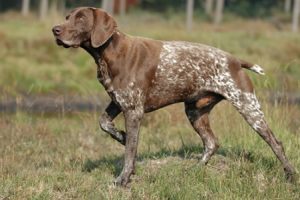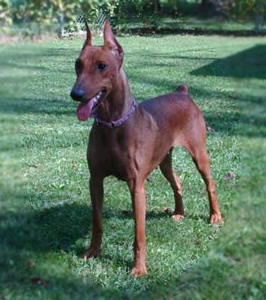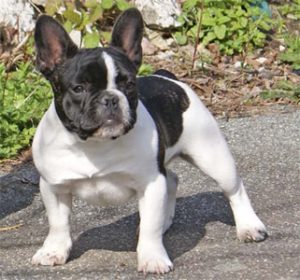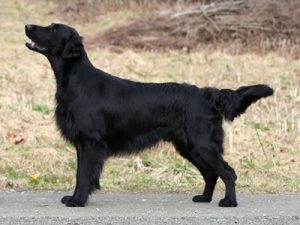
The German Shorthaired Pointer (GSP) is a breed of dog developed in the 1800s in Germany for hunting.
The breed is streamlined yet powerful with strong hindquarters that make it able to move rapidly and turn quickly. It has moderately long flop ears set high on the head. Its muzzle is long, broad, and strong, allowing it to retrieve even heavy game. The dog’s profile should be straight or strongly Roman nosed; any dished appearance to the profile is incorrect. The eyes are generally brown, with darker eyes being desirable; yellow or “bird of prey” eyes are a fault. The tail is commonly docked, although this is now prohibited in some countries. The correct location for docking for GSP is after the caudal vertebrae start to curl, leaving enough tail to let the dog communicate through tail wagging and movement. The docked tail should not be too long or too short but should balance the appearance of the head and body. The GSP tail is carried at a jaunty angle, not curled under. When the GSP is in classic point stance, the tail should be held straight out from the body forming a line with the pointing head and body. Like all German pointers, GSP have webbed feet.
Coat and colour
The German Shorthaired Pointer’s coat is short and flat with a dense undercoat protected by stiff guard hairs making the coat water resistant and allowing the dog to stay warm in cold weather. The colour can be a dark brown, correctly referred to in English as “liver” (incorrectly as “chocolate” or “chestnut”, black (although any area of black is cause for disqualification in American Kennel Club sanctioned shows), or either liver and white or black and white. Commonly the head is a solid or nearly solid colour and the body is speckled or “ticked” with liver and white, sometimes with large patches of solid colour called “saddles”. Roan coats are also common, with or without patching. Solid liver and solid black coats also occur, often with a small blaze of ticking or white on the chest. While the German standard permits a slight sandy colouring (“Gelber Brand” at the extremities, this colouring is rare, and a dog displaying any yellow colouring is disqualified in AKC and CKC shows. The colouring of the GSP provides camouflage in the winter seasons. When standing next to dead trees and in broken snow, the white and dark brown coat makes the dog difficult to see.
Temperament
Since the German Shorthaired Pointer was developed to be a dog suited to family life as well as a versatile hunter, the correct temperament is that of an intelligent, bold, and characteristically affectionate dog that is cooperative and easily trained. They rank 17th in Stanley Coren’s The Intelligence of Dogs, being excellent working dogs. Shyness, fearfulness, over submissiveness, aloofness, lack of biddability, or aggression (especially toward humans) are all incorrect traits. The GSP is usually very good with children, although care should be taken because the breed can be boisterous especially when young. These dogs love interaction with humans and are suitable pets for active families who will give them an outlet for their energy. Most German Shorthaired Pointers make excellent watchdogs. The breed generally gets along well with other dogs. A strong hunting instinct is correct for the breed, which is not always good for other small pets such as cats or rabbits. With training, however, the family dog should be able to discern what is prey and what is not, and they can live quite amicably with other family pets.
The German Shorthaired Pointer needs plenty of vigorous activity. This need for exercise (preferably off lead) coupled with the breed’s natural instinct to hunt, means that training is an absolute necessity. The GSP distinctly independent character and superior intelligence mean that any unused energy will likely result in the dog amusing itself, most probably in an undesirable manner.
Failure by the owner to give this active and intelligent dog sufficient exercise and/or proper training can produce a German Shorthaired pointer that appears hyperactive or that has destructive tendencies. Thus the breed is not a suitable pet for an inactive home or for inexperienced dog owners. Although these dogs form very strong attachments with their owners, a bored GSP that receives insufficient exercise may feel compelled to exercise himself. These dogs are athletic and can escape from four foot and sometimes six foot enclosures with little difficulty. Regular hunting, running, carting, bikejoring, skijoring, mushing, dog scootering or other vigorous activity can alleviate this desire to escape. The natural instinct to hunt may result in the dog hunting alone and sometimes bringing home occasional dead trophies, such as cats, rats, pigeons and other urban animals. In addition to exercise, especially formal hunting, the GSP needs to be taught to distinguish legitimate prey and off limits animals.
Like the other German Pointers (the German Wire-haired Pointer and the less well known German Longhaired Pointer), the GSP can perform virtually all gundog roles. It is pointer and retriever, an upland bird dog and water dog. The GSP can be used for hunting larger and more dangerous game, and in addition has a scent hound’s talented nose. It is an excellent swimmer but also works well in rough terrain. It is tenacious, tireless, hardy, and reliable. In short, it is a superb all-around field dog that remains popular with hunters of many nationalities.
The GSP is intelligent and bred for a certain amount of independence (e. g., when a dog is working out of sight or sound of its handler in the field). Along with its superb hunting ability and companionable personality, the intelligence and the obedience of the GSP make it one of the more popular large breeds.
During hunting sessions, a completely instinctive scent-hiding activity through rubbing against carrion can be observed.
—————————————————————————————————————–
CARING FOR YOUR DOG NEWSLETTER – Delivered Directly To Your Inbox – Starting Immediately – SIGN UP FOR FREE TODAY
—————————————————————————————————————–




